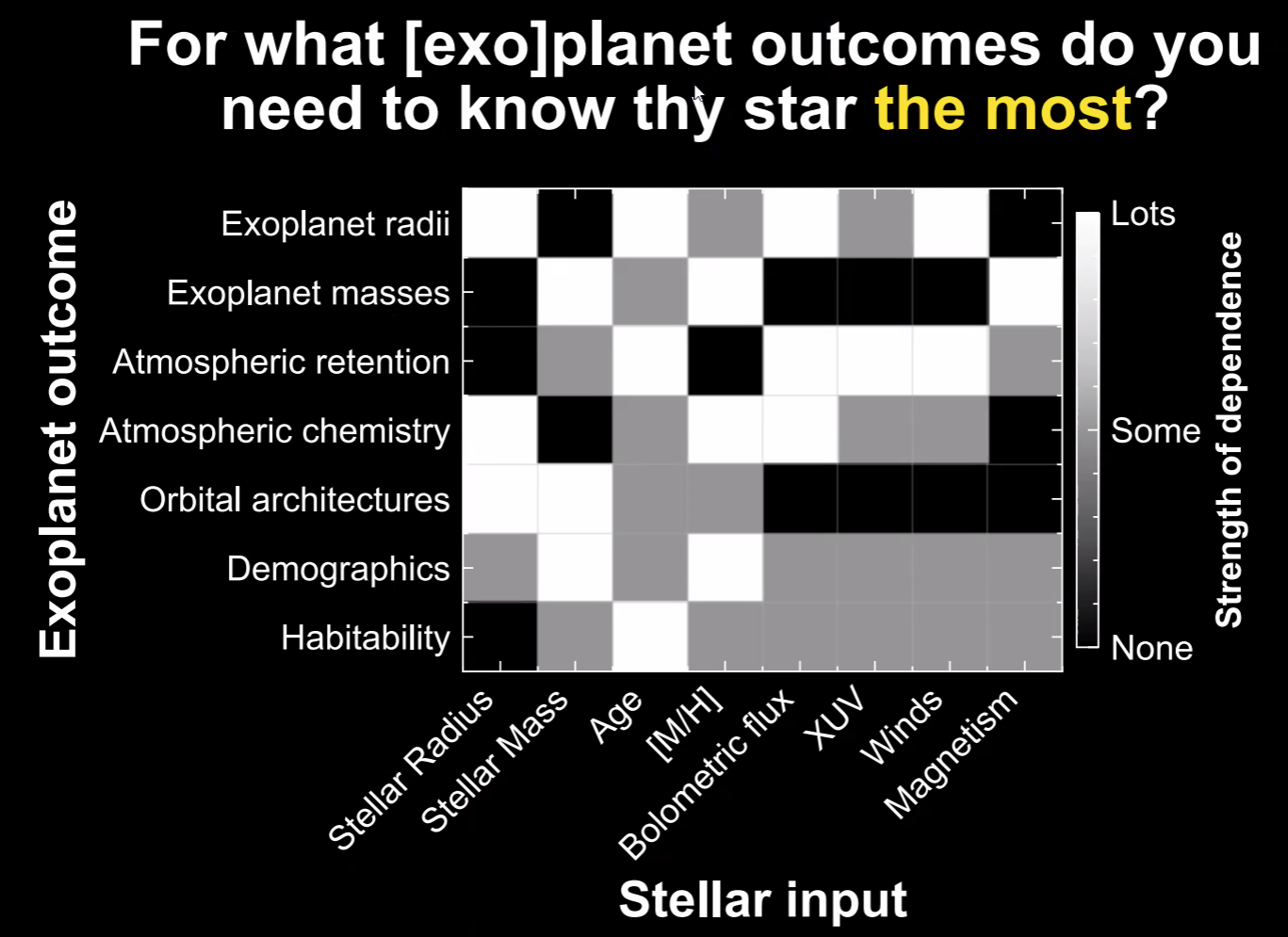Luke Bourma: Wow great summary plot of how the measurements of different exoplanet properties depend on precise measurements of different stellar properties.
-
Luke Bourma: Wow great summary plot of how the measurements of different exoplanet properties depend on precise measurements of different stellar properties.
Stellar metallicity sets mass budget for planets. Stellar ages set planet evolution timeline.
Mini-Neptunes may evolve into super-Earths over time as their atm's evaporate. Multiplanet transiting systems commonly have MMRs.
Young stars spin faster, good age measure (for some).
-
Luke Bourma: Wow great summary plot of how the measurements of different exoplanet properties depend on precise measurements of different stellar properties.
Stellar metallicity sets mass budget for planets. Stellar ages set planet evolution timeline.
Mini-Neptunes may evolve into super-Earths over time as their atm's evaporate. Multiplanet transiting systems commonly have MMRs.
Young stars spin faster, good age measure (for some).
Jorge Sanchez talking about low metallicity, old brown dwarfs, which are good analogues for exoplanets, and they're not right next to super bright stars so easier to study. Got JWST data on some of the most distant, most metal-poor brown dwarfs! Need confirmation still in future JWST data though.
-
Jorge Sanchez talking about low metallicity, old brown dwarfs, which are good analogues for exoplanets, and they're not right next to super bright stars so easier to study. Got JWST data on some of the most distant, most metal-poor brown dwarfs! Need confirmation still in future JWST data though.
Laura Rogers talking about "polluted white dwarfs" - white dwarfs that have eaten exoplanets (or at least asteroids) and astronomers can measure the composition of accreted material
-
Laura Rogers talking about "polluted white dwarfs" - white dwarfs that have eaten exoplanets (or at least asteroids) and astronomers can measure the composition of accreted material
Erika Le Bourdais has a beautiful explanation diagram. A record: 13 metals found in one white dwarf, can extract mass of metals. Would have been an asteroid at least 150-200km in size that got eaten by the white dwarf
-
 undefined Oblomov shared this topic on
undefined Oblomov shared this topic on
-
Erika Le Bourdais has a beautiful explanation diagram. A record: 13 metals found in one white dwarf, can extract mass of metals. Would have been an asteroid at least 150-200km in size that got eaten by the white dwarf
Shih-Yun Tang is talking about all the cool science and detailed surface mapping you can do with lightcurves and giant starspots on young, active, small stars.
#SolarSystemInContext -
Shih-Yun Tang is talking about all the cool science and detailed surface mapping you can do with lightcurves and giant starspots on young, active, small stars.
#SolarSystemInContextTyler Robinson asks: is abiogenesis the norm? Does life arise on all habitable planets? Or are there lots of uninhabited, habitable planets?
For exoplanets we're more focused on surface habitability, because that's all we can probe. How do you define habitability? Hoo boy, complicated.
Galileo probe did direct detection of surface habitability during Earth grav-assist flyby. Liquid water! Temp measurements!
-
Tyler Robinson asks: is abiogenesis the norm? Does life arise on all habitable planets? Or are there lots of uninhabited, habitable planets?
For exoplanets we're more focused on surface habitability, because that's all we can probe. How do you define habitability? Hoo boy, complicated.
Galileo probe did direct detection of surface habitability during Earth grav-assist flyby. Liquid water! Temp measurements!
Ocean glinting is important for direct detection (Rosetta probe also saw this during Earth flybys). On exoplanets, this could depend on atmospheric composition - thin aerosols could cause false positive.
Measuring T and P can be done from reflected light spectrum too, but is average over whole atmosphere column, not just surface.
TRAPPIST-1e has JWST transit spectrum now, but messy! Some constraint from atm models.
-
Ocean glinting is important for direct detection (Rosetta probe also saw this during Earth flybys). On exoplanets, this could depend on atmospheric composition - thin aerosols could cause false positive.
Measuring T and P can be done from reflected light spectrum too, but is average over whole atmosphere column, not just surface.
TRAPPIST-1e has JWST transit spectrum now, but messy! Some constraint from atm models.
Suvarth Mahadevan talking about Habitable-zone Planet Finder instrument on Hobby-Eberly Telescope (which incidentally has a bullet hole in the mirror, because... Texas)
This is optimized for cool M stars - smaller planets around small stars produce larger radial velocity signatures. M stars are hard targets, very active "the technical term is, SUCK" hahaha
GJ 251, 20 years of RV data, found superearth in hab zone! Good target for ELT direct imaging.
-
Suvarth Mahadevan talking about Habitable-zone Planet Finder instrument on Hobby-Eberly Telescope (which incidentally has a bullet hole in the mirror, because... Texas)
This is optimized for cool M stars - smaller planets around small stars produce larger radial velocity signatures. M stars are hard targets, very active "the technical term is, SUCK" hahaha
GJ 251, 20 years of RV data, found superearth in hab zone! Good target for ELT direct imaging.
Chaucer Langbert: if you could watch the evolution of 1,000 Earth-like planets, how many stay habitable for 1 billion years?
Feedback is impt: ice-albedo, carbonate-silicate, radiative-water vapour. Does this hold for other planets?
In sims, sees runaway (Venus/Mars-like), hot-cold cycles, chaos. Bigger transitions when sun gets brighter over Gyr.
-
Chaucer Langbert: if you could watch the evolution of 1,000 Earth-like planets, how many stay habitable for 1 billion years?
Feedback is impt: ice-albedo, carbonate-silicate, radiative-water vapour. Does this hold for other planets?
In sims, sees runaway (Venus/Mars-like), hot-cold cycles, chaos. Bigger transitions when sun gets brighter over Gyr.
Danica Adams: sulfuric acid haze (like on Venus) could actually help cool down Venus-like planets early. Water vapour percentage make a big difference to haze formation and albedo. Could test this with exo-Venuses if any found?
